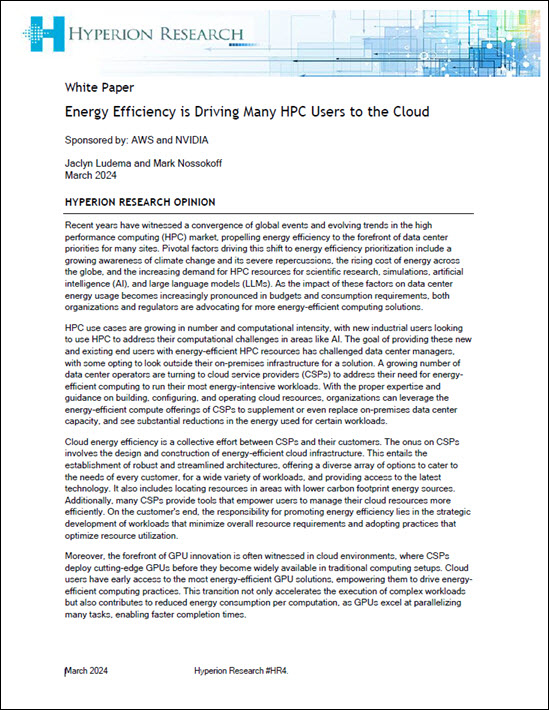The Association for Computing Machinery, named Amanda Randles of Duke University the recipient of the ACM Prize in Computing for groundbreaking contributions to computational health through innovative ….
Duke Researcher Dr. Amanda Randles Wins ACM Prize in Computing for Medical Diagnostics
CINECA Selects E4 Computer with Dell and Vast for Galileo 100 HPC Upgrade
April 23, 2024 — E4 Computer Engineering has won the contract to upgrade Galileo 100, CINECA Interuniversity Consortium’s supercomputer and Tier-1 cloud system for public scientific research capable of serving over 5000 users. Among the requirements for the new HPC infrastructure are increasing the number of vCPUs for VM services by at least 10 times, […]
Eviden Delivers 104 Pflops Nvidia-Powered EXA1-HE Supercomputer for CEA
Paris – April 17, 2024 – CEA (The French Alternative Energies and Atomic Energy Commission) and Eviden, the Atos advanced computing business unit, today announce the delivery of the EXA1 HE supercomputer, based on Eviden’s BullSequana….
Stanford AI Index: Lax LLM Reponsibility, AI for Science Accelerates, Impact on Workers, US Leads China in Models
The AI Index Report from Stanford’s Institute for Human-Centered AI is out, it’s an annual, thoroughgoing snapshot of the state of AI begun by the HAI in 2019. This year’s edition presents new estimates on AI training….
Classiq and Quantum Intelligence Partner on Drug Development
SEOUL, SOUTH KOREA and TEL AVIV, ISRAEL | April 04, 2024 — Quantum computing software company Classiq and Quantum Intelligence Corp. today announced the launch of joint research for drug development by applying quantum computing to pharmacology. The collaboration is under the auspices of Classiq’s Quantum Computing For Life Sciences & Healthcare Center, launched with NVIDIA […]
SK hynix to Invest $3.9B in Indiana HBM Fab and R&D with Purdue
Memory chip company SK hynix announced it will invest $3.87 billion in West Lafayette, Indiana to build an advanced packaging fabrication and R&D facility for AI products. The project, which the company said is the first of its kind in the U.S., will be an advanced….
Exascale Software and NASA’s ‘Nerve-Racking 7 Minutes’ with Mars Landers
NASA supercomputers have helped several Mars landers survive the nerve-racking seven minutes of terror. During this hair-raising interval, a lander enters the Martian atmosphere and needs to automatically execute many crucial actions in precise order….
ALCF Announces Online AI Testbed Training Workshops
The Argonne Leadership Computing Facility has announced a series of training workshops to introduce users to the novel AI accelerators deployed at the ALCF AI Testbed. The four individual workshops will introduce participants to the architecture and software of the SambaNova DataScale SN30, the Cerebras CS-2 system, the Graphcore Bow Pod system, and the GroqRack […]
@HPCpodcast: Matt Sieger of OLCF-6 on the Post-Exascale ‘Discovery’ Vision
What does a supercomputer center do when it’s operating two systems among the TOP-10 most powerful in the world — one of them the first system to cross the exascale milestone? It starts planning its successor. The center is Oak Ridge National Lab, a U.S. Department….
Exascale Computing Project: Leveraging HPC and Neural Networks for Cancer Research
What happens when Department of Energy (DOE) researchers join forces with chemists and biologists at the National Cancer Institute (NCI). They use the most advanced high-performance computers to study cancer at the molecular, cellular and population levels.













